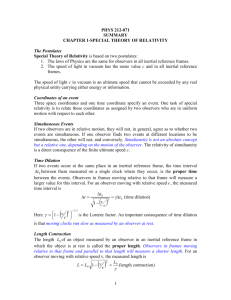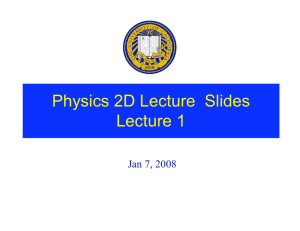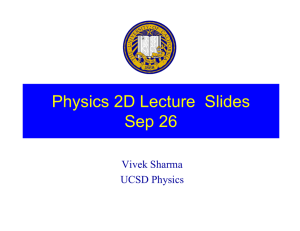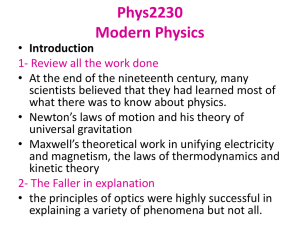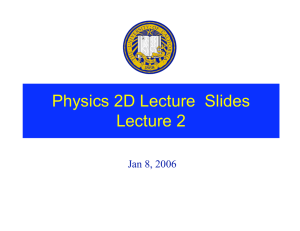Physics 2D Lecture Slides Lecture 2 March 31, 2009
advertisement
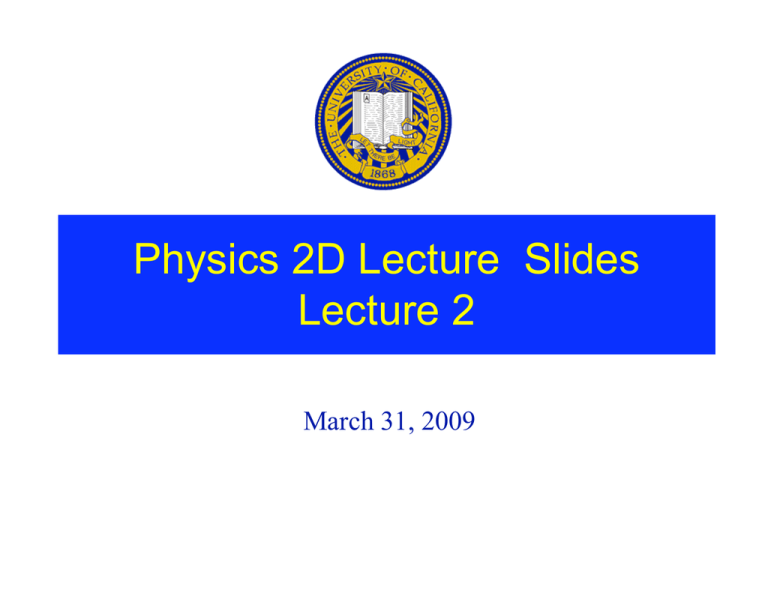
Physics 2D Lecture Slides Lecture 2 March 31, 2009 Newton’s Laws and Galilean Transformation ! • But Newton’s Laws of Mechanics remain the same in All frames of references ! 2 2 d x ' d x ' dv = 2 " 2 dt dt dt ! a' = a ! ! ! F'= F Description of Force does not change from one inertial frame of reference to another Newtonian/Galilean Relativity Inertial Frame of Reference is a system in which a free body is not accelerating Laws of Mechanics must be the same in all Inertial Frames of References ⇒Newton’s laws are valid in all Inertial frames of references ⇒No Experiment involving laws of mechanics can differentiate between any two inertial frames of reference ⇒Only the relative motion of one frame of ref. w.r.t other can be detected ⇒ Notion of ABSOLTUTE motion thru space is meaningless ⇒There is no such thing as a preferred frame of reference Light Is An Electromagnetic Wave (2C) • Maxwell’s Equations: permeability Speed of light constant ! permittivity Measuring The Speed Of Light High Technology of 1880’s: Fizeau’s measurement of speed of light 1. Shoot pulses of light to mirror 2. Light should take t = 2L/c to get back to Observer 3. Adjust the angular velocity of wheel such that reflected light from mirror makes it back to observer thru the next gap C = 2.998 x 108 m/s (in vacuum) Now repeat the experiment Anywhere you wish Measure same speed Does Light Need a Medium to Propagate ? • EM waves are a different – What is the required medium of propagation ? Aether ?? • How to verify whether Aether exists or not? – ( Always ) Do an Experiment ! • The Michelson-Morley Interferometer – Interferometer: device used to measure • Lengths or changes in lengths – Measured with great accuracy • Using interference fringes • HW Reading : Section 1.3 – If you don’t understand this, pl. review • Wave Phenomena • Bottomline: Light needs no medium Galilean Relativity and EM Waves O It would appear to Observer O in S frame that velocity of light VS = c + v > c This contradicts Maxwell’s theory of Light ! Are Newton’s Laws and Maxwell’s laws inconsistent??!! Newtonian Relativity & Light ! Light source, mirror & observer moving thru some medium with velocity V Galilean Relativity • If the alien measures velocity of light = c •Then observer must measure speed of light = c-v when it is leaving him =c+v when it is reflected back Alien dude But Maxwell’s Eq speed of light is constant in a medium?? Must it be that laws of Mechanics behave differently from E&M in different inertial frames of references ? …if so how inelegant would nature be! Einstein’s Special Theory of Relativity Einstein’s Postulates of SR – The laws of physics must be the same in all inertial reference frames – The speed of light in vacuum has the same value (c = 3.0 x 108 m/s ) , in all inertial frames, regardless of the velocity of the observer or the velocity of the source emitting the light. Consequences of Special Relativity: Simultaneity not Absolute Simultaneity: When two events occur at same time, held absolute for Classical Phys Lightning bolts Events that are simultaneous for one Observer are not simultaneous for another Observer in relative motion Simultaneity is not absolute !! Time interval depends on the Reference frame it is measured in A Simple Clock Measuring a Time Interval t = " !t One hour = 60 x 1 minute time intervals Time Dilation and Proper Time Watching a time interval (between 2 events) with a simple clock 2d c Observer O : Apply Pythogoras Theorem Observer O' : "t ' = 2 2 2 # c"t $ # v"t $ # c"t ' $ = d + , but d = ( ) % & % & % & ' 2 ( ' 2 ( ' 2 ( ) c 2 ("t ) = c 2 ("t ' ) + v 2 ("t ) ) "t = 2 2 "t ' #v$ 1* % & 'c( 2 2 = ! "t ', "t > "t ' 1 # v2 / c2 as v " 0, ! " 1 as v " c , ! " $ Speed of light barrier Th γ e r o t c fa ! = 1 Measuring Time: Period of a Pendulum • Period of a pendulum is 3.0 s in the rest frame of the pendulum • What is period of the pendulum as seen by an observer moving at v=0.95c Answer: • Proper time T’ = 3.0s • Since motion is relative and time dilation does not distinguish between • relative motion (V) from relative motion (-V) • lets reformulate the problem like this (??) • A pendulum in a rocket is flying with velocity V =0.95c past a stationary observer •Moving clocks runs slower [w.r.t clock in observer’s hand (rest)] by factor γ • Period T measured by observer = γ T’ != 1 1 $ (v / c ) 2 = 1 1 $ (0.95) 2 = 3.2 " T = ! T ' = 3.2 # 3.0 s = 9.6 s Moving pendulum slows down takes longer to complete a period
